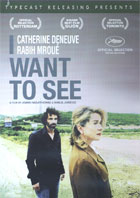
I Want to See (Je VeuxVoir) 2008
Distributed by Typecast Releasing, 3131 Western Ave., Suite 514, Seattle, WA 09121; 206-322-0882
Producer N/A
Directed by Joana Hadjithomas and Khalil Joreige
DVD, color, 70 min.
College - General Adult
Middle Eastern History, Current Affairs, Film Studies
Date Entered: 04/24/2012
Reviewed by Dennis J. Seese, Reference Librarian, American UniversityBorn in Beirut in 1969, the filmmakers Joana Hadjithomas and Khalil Joreige have lived nearly their entire lives within a Lebanon whose physical and psychological landscape has been continuously distorted and deconstructed by nearly constant bursts of war. In their award-winning film I Want to See the directors explore the difficulty of truly ‘seeing’ images of war from any perspective whether it be that of participants, victims or spectators thousands of miles away, while simultaneously commenting on the nature of cinema itself and what it means to collect and view photographic images. I Want to See blurs the boundaries between documentary filmmaking, improvisation and scripted narrative, employing techniques and conventions from all three.
The legendary, iconic French actress Catherine Deneuve was chosen by the directors to represent the literal, living embodiment of “cinema” and she, as does everyone else in the film, appears on screen as herself. Deneuve is in Lebanon to attend a gala and she asks to be taken to South Lebanon so she can see the damage resulting from the most recent war between Israel and Lebanon in 2006. The directors arrange a meeting between Deneuve and Lebanese actor Rabih Mroue wherein Mroue agrees to drive Deneuve to the Lebanese coast with plans to stop at his ancestral village Bint El Jbeil on the way. Mroue and Deneuve represent each side of the aforementioned dialogue/dichotomy the filmmakers seek to examine about what it means to “see,” as he explicitly doesn’t want to see and in some ways is unable to see the damage (it has already been internalized) surrounding him and she wants desperately to see, to try and understand, to somehow bridge the distance as a spectator consuming images of war safely from afar.
The documentary style photography is stark and basic as the camera appears on the hood of the car recording the forced intimacy and nervous small-talk of strangers as the car prowls slowly through a Beirut scarred by remnants of war. Mroue functions as a narrator identifying layers of damage unique to specific wars amidst shocking scenes of people combing through three-story high piles of rubble resembling jagged, grotesquely inverted concrete stalactites.
A jarring switch in perspective occurs as Mroue and Deneuve take the road out of Beirut and the camera switches to a backseat vantage point and the viewer sees Lebanon unfolding around them as they do. The car ambles down otherwise sleepy rural roads strewn with posters of martyrs that serve as constant reminders of loss and destruction. They arrive at Bint El Jbeil to find it shattered and unrecognizable and Mroue’s poignant, dazed trudge through the rubble is the emotional epicenter of the film. A bright light abruptly dissolves that scene and suddenly they’re back in the car and Mroue in voiceover starts reciting Deneuve’s monologue from Belle de Jour. She asks him to say it in Arabic and they get so engrossed in the language of cinematic memory that they drive onto a road littered with landmines. The end of their journey is a coast marred by rust and rubble, as the detritus of war is moved from the suburbs of Beirut to the sea and mounds of rebar and cement lie on the shore like mammoth rusty whales, a regurgitated city on the precipice of the sea.
The metanarrative line that I Want to See straddles (sometimes clumsily and uncomfortably) between cinema and documentary seems to function as a commentary on the inability of genre and convention to convey Lebanon’s reality—as well as the limitations of the cinematic art form itself. The concept of ‘seeing’ is integral to this film as evinced, of course, by the title’s direct allusion but the filmmakers also seem to be commenting on the pictures and images of war that bombard us constantly as well as the willful blindness of the victims of war, the damage done to their ability to perceive, to see solutions, to see beauty. Can cinema play a role in their regeneration? That is one of the pivotal questions posed by the directors of I Want to See. Can showing people images collected through camera lens actually make people ‘see’ the horror and damage they contain? The evidence collected within this film is fascinatingly mixed, but I Want to See is a penetrative work that will hopefully inspire further cinematic exploration of the questions it poses.